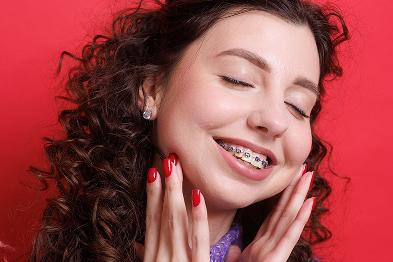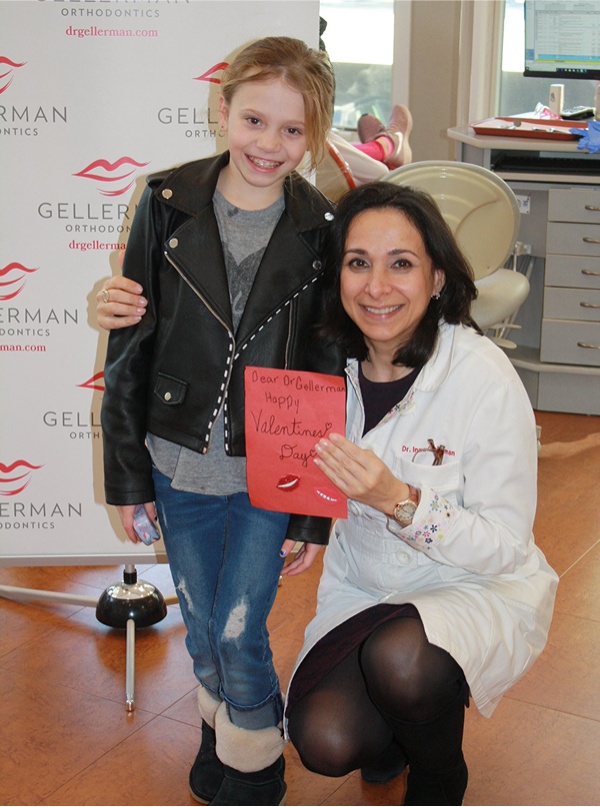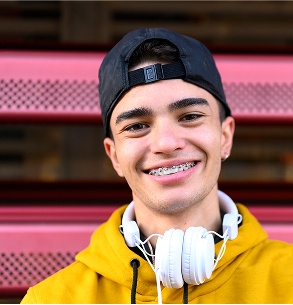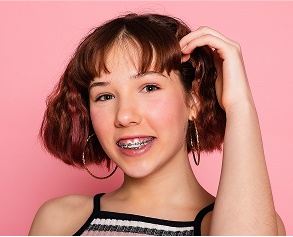Types of Braces
At Gellerman Orthodontics, we offer a range of braces options to fit your lifestyle, preferences, and orthodontic needs. Whether you’re looking for a traditional and effective solution or a more discreet alternative, we have the right treatment for you.
Each type of braces has unique benefits, and the best choice depends on your orthodontic needs, lifestyle, and personal preferences. During your consultation at Gellerman Orthodontics, we’ll discuss your options and create a treatment plan tailored to you. Whether you choose metal, ceramic, or lingual braces, you can trust that you’re receiving the highest level of care for a confident, healthy smile.

Metal braces are the most well-known and widely used type of braces. Made from high-quality stainless steel, today’s braces are smaller, sleeker, and more comfortable than ever before. They use brackets, archwires, and elastics to gradually shift your teeth into their ideal positions.


For patients who want a completely invisible orthodontic solution, lingual braces are an excellent choice. These braces are placed on the back (lingual side) of your teeth, making them completely hidden from view.
Orthodontic Braces in Huntington, NY

Is Early Orthodontic Treatment Necessary for Kids?
Yes — early treatment can make a big difference in your child’s future smile and oral health. Starting orthodontic care at the right time helps guide jaw growth, create room for permanent teeth, and correct harmful habits before they lead to bigger problems.
The American Association of Orthodontists recommends that kids have their first orthodontic evaluation by age seven, even if baby teeth are still present. At this age, we can catch potential issues early and decide whether your child may benefit from early treatment.
What Issues Can Early Treatment Fix?
Braces for kids are often part of a two-phase treatment approach. In Phase One, we focus on addressing developmental concerns before all permanent teeth come in. Early treatment can help with:
- Crowded or spaced teeth
- Overbites, underbites, or crossbites
- Jaw growth and alignment issues
- Thumb-sucking or tongue-thrust habits
By guiding growth early, we may prevent the need for tooth extractions or jaw surgery later. It also makes future orthodontic treatment faster and more effective.

Can Early Treatment Help Create Space for Permanent Teeth?
Yes — one of the biggest benefits of early orthodontic treatment is expansion. For many children, the upper jaw is too narrow to allow all permanent teeth to come in properly. This can lead to crowding, misalignment, and even the need to extract healthy teeth later on.
Using tools like palatal expanders and space-maintaining appliances, we can gently guide jaw development and create the space needed for future teeth to erupt naturally. This not only supports a healthier bite but also helps avoid more invasive treatments later.
By starting early, we can prevent permanent teeth from becoming impacted or misaligned, reducing the likelihood of extractions or surgical intervention. Expansion is a safe, effective way to support proper facial and dental development, and it’s a key reason why we recommend evaluating your child’s smile as early as age seven.
What Are the Braces Options for Kids?
We offer metal, ceramic, and lingual braces — all are strong, reliable, and effective. Many kids enjoy customizing their braces with colorful elastics, making treatment a fun and creative experience.
Since kids’ bones are still developing, treatment is often more efficient than in older teens or adults. This means shorter treatment times and fewer adjustments over the course of care.
Dr. Gellerman has developed a personalized approach called The Gellerman Method, designed specifically for growing patients. Using 3D digital X-rays and high-resolution photographs, we create a treatment plan that’s tailored to your child’s unique anatomy and needs.
Benefits of The Gellerman Method include:
- Up to 40% faster treatment times
- Pain-free care with fewer adjustments
- Minimal need for extractions
- Personalized care that fits your child’s lifestyle
- Focus on both function and appearance for lasting results
Absolutely! Braces won’t keep your child from doing what they love. Whether they’re into sports, music, or other hobbies, our team will help them adjust smoothly.
We’ll walk you through braces-friendly foods (like pasta, yogurt, and soft fruits) and help your child avoid things that can damage their braces—like sticky candy or crunchy snacks. We’ll also teach proper brushing and flossing techniques, including tools like interdental brushes, to make cleaning easy.
If your child plays contact sports, a mouthguard will help keep their smile safe. With the right care and support, your child can enjoy life — and a healthier smile — without skipping a beat.
The first step is easy: schedule an orthodontic evaluation. We’ll assess your child’s growth, bite, and alignment to see if early treatment is right for them. If it’s not needed yet, we’ll simply monitor their progress and recommend treatment at the best time.
At Gellerman Orthodontics, we’re here to guide your child toward a healthier, more confident smile — from their first appointment to their final result.



The teenage years are the ideal time for orthodontic treatment. With most permanent teeth in place and the jaw still developing, braces can effectively shape a straight, healthy smile that lasts a lifetime. While braces are an exciting step toward a confident smile, we know that teens have busy lives filled with school, sports, and social events. That’s why we focus on making the orthodontic experience as smooth and stress-free as possible.
Adjusting to braces takes a little time, but most teens find that they quickly get used to them. Mild soreness is common after adjustments, but it fades within a few days. Eating softer foods and using orthodontic wax can help with any initial discomfort.
While braces are strong, certain foods can damage brackets and wires. Teens should avoid:
- Sticky foods (gum, caramel, chewy candies)
- Hard foods (nuts, popcorn, ice, hard candies)
- Crunchy foods (raw carrots, apples, chips — unless cut into small pieces)
- The good news? There are still plenty of delicious foods to enjoy, including pasta, soft fruits, yogurt, and smoothies.
- Brush after every meal with a soft-bristled toothbrush
- Floss daily using floss threaders or a water flosser
- Avoid sugary drinks that can cause plaque buildup around brackets
It’s one of the first questions many teens ask: “How long do I have to wear braces?” The exact length of treatment depends on several important things, including:
- Early Treatment — For some patients, two-phase treatment is needed, and whether you had early treatment or not can impact the amount of time you need to wear braces. In the first phase of the treatment, treatment helps the jaw develop better, which can put you in a better position for effective straightening with braces later. Early treatment can happen as early as age seven.
- Correction Needs — Your correction needs can have a major impact on total time in braces. If you need complex straightening, it may take longer, while minor alignment issues generally require shorter time in braces. Some teenagers only need 12 months in braces while others can take up to 24 months.
- Your Participation — Your participation is a big part of braces success, so it plays a role in total braces time, too. Be sure to follow all of our guidelines and recommendations and see us for your check-up appointment on time to make sure you wear braces for the shortest time possible.



- Crowded or misaligned teeth
- Bite problems (such as overbite, underbite, or crossbite)
- Gaps between teeth
- TMJ issues or jaw discomfort
In young patients, the jaw is still somewhat soft because it’s still developing. But, as an adult your jaw is already fully developed — and may have been that way for years. That means that adult orthodontics can be more challenging, and might take longer, than the treatment you would have as a child or teen. As an adult, you’re also more likely than children to have periodontal disease or worn or missing teeth, both of which can increase the challenge of orthodontic treatment. These are all good reasons why you need truly customized care like The Gellerman Method.
Sometimes, adults had incomplete orthodontic treatment when they were young, or never had any orthodontic care at all, but it’s never too late to straighten your teeth. Even if you’ve spent an entire lifetime with crooked teeth, Dr. Gellerman can help with a customized adult orthodontics plan.
Many adults prefer discreet treatment options, which is why we offer ceramic braces and lingual braces for a nearly invisible experience. Lingual braces, placed on the back of your teeth, allow you to straighten your smile without anyone noticing. If you’re looking for a traditional, effective solution, metal braces are also available and more advanced than ever before.
We understand that adults have busy schedules, which is why we use advanced orthodontic technology to make treatment as efficient and comfortable as possible. Braces aren’t just about aesthetics — they also improve oral health by making teeth easier to clean, reducing the risk of cavities and gum disease. Investing in orthodontic treatment as an adult leads to a healthier, more confident smile for years to come!